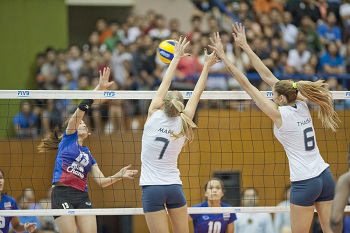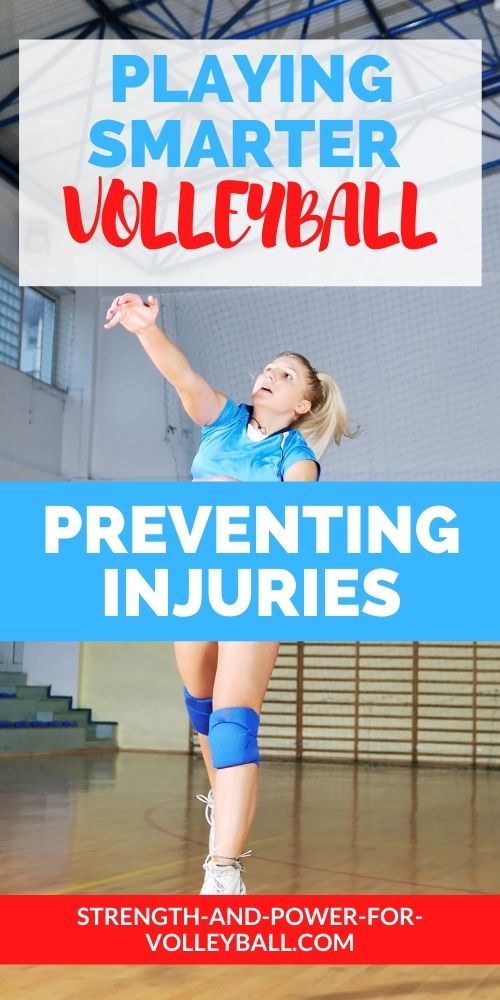- Home
- Smarter Training
- volleyball ankle braces
Volleyball Ankle Braces
Prevent Injury & Improve Performance
Volleyball ankle braces have become commonplace for many volleyball players regardless of whether or not they have ever injured their ankles.
I've seen youth volleyball players as young as 11 years old wearing ankle braces. Are ankle braces right for all volleyball players?
Why Ankle Braces?
Ankle sprains are the most common sports-related injuries in the United
States, accounting for an estimated 2 million injuries per year. (1)
Most ankle sprains occur when landing from a jump, with the foot in an inverted, plantar-flexed position.
The image on the left is the most common type of ankle sprain for volleyball
players.
Ankle Proprioception
Several studies support the theory that ankle sprains frequently involve
disruption in ankle proprioception preventing the ankle from being able
to protect itself.
Proprioception is similar to balance in that it provides a sense of joint position and movement.
The ability to adjust proprioception helps prevent ankle sprains by helping the muscle
respond to abnormal positions and situations.
Eversion ankle sprains, on the other hand, are usually not related to
inadequate proprioception but are the result of outside forces
such as contact by another athlete. Eversion ankle sprains are less
common in
volleyball.
Did you know plyometric exercises can help strengthen ankles?
Do taped ankles or braced ankles decrease the incidence and severity of sprains in taped or braced athletes?
A study by Robbins (2) showed that taped participants had improved
proprioception both before and after exercise compared with untaped
controls.
The author basically said that ankle via taping or bracing provided
improved sensory input and improved proprioception, resulting in fewer
ankle sprains.
If you enjoyed these tips and would like to keep it close to you at any time, just save this pin to your Pinterest Volleyball Training Board.
Does taping or bracing result in weak ankles?
Another common concern coaches have when coaching volleyball
is that prolonged taping or bracing of the ankle results in weak ankles that then become more prone to injury.
If this were true, this would obviously be a strong case against the use of taping or bracing
for ankles.
However,
a recent study showed the effects of consistent ankle brace use on an important stabilizer
muscle of the ankle, particularly against inversion, the most common type of ankle injury. This study showed that
the muscles latency to inversion was not changed by the prolonged wearing of an ankle brace.
Taping to bracing vs Volleyball Ankle Braces
The concept of ankle bracing evolved from ankle taping. Braces are being used instead of traditional taping by many
volleyball players.
Volleyball ankle braces offer several advantages in that they are
self-applied, reusable, and readjustable. In the long run, they are
likely more cost-effective than taping.
There are generally two types of braces.
The first type is nonrigid and resembles a thick canvas or nylon lace-up sock. Some nonrigid braces are also made of neoprene.
The nonrigid style imparts some compression to the ankle and may help in
injury prophylaxis but provides little medial or lateral stability to
the ankle.
The the semi-rigid is the second type of ankle brace. Its construction
is similar to the nonrigid but with the added feature of molded plastic
struts or air cushions.
These
struts are incorporated into the medial and lateral sides of the brace,
similar in orientation to the stirrups used in ankle taping.
Many athletes use these braces for support during rehabilitation and return-to-play phases of ankle injury.
Also, these types of volleyball ankle braces have been popular for volleyball
players because they provide added stability that helps
prevent ankle injury.
Ankle Supports for Volleyball
Most nonrigid and semirigid braces also use fabric straps
to simulate heel locks. These are usually on the outside of the brace
and fastened with Velcro.
Some disadvantages to brace instead of taping is that many athletes don't feel as comfortable
wearing them.
Also, another disadvantage of braces is they may not feel as stable as taping.
Also, over time, braces can
wear out or the athlete might misplace them.
Although studies regarding effectiveness and technique are not all in
agreement, it seems that wearing volleyball ankle braces and taping
ankles will continue to be
routine for volleyball players.
References
1. Ivins D. Acute ankle sprain: an update. Am Fam Physician. Nov 15 2006;74(10):1714-20.
2. Robbins S, Waked E. Factors associated with ankle injuries. Preventive measures. Sports Med. Jan 1998;25(1):63-72.

